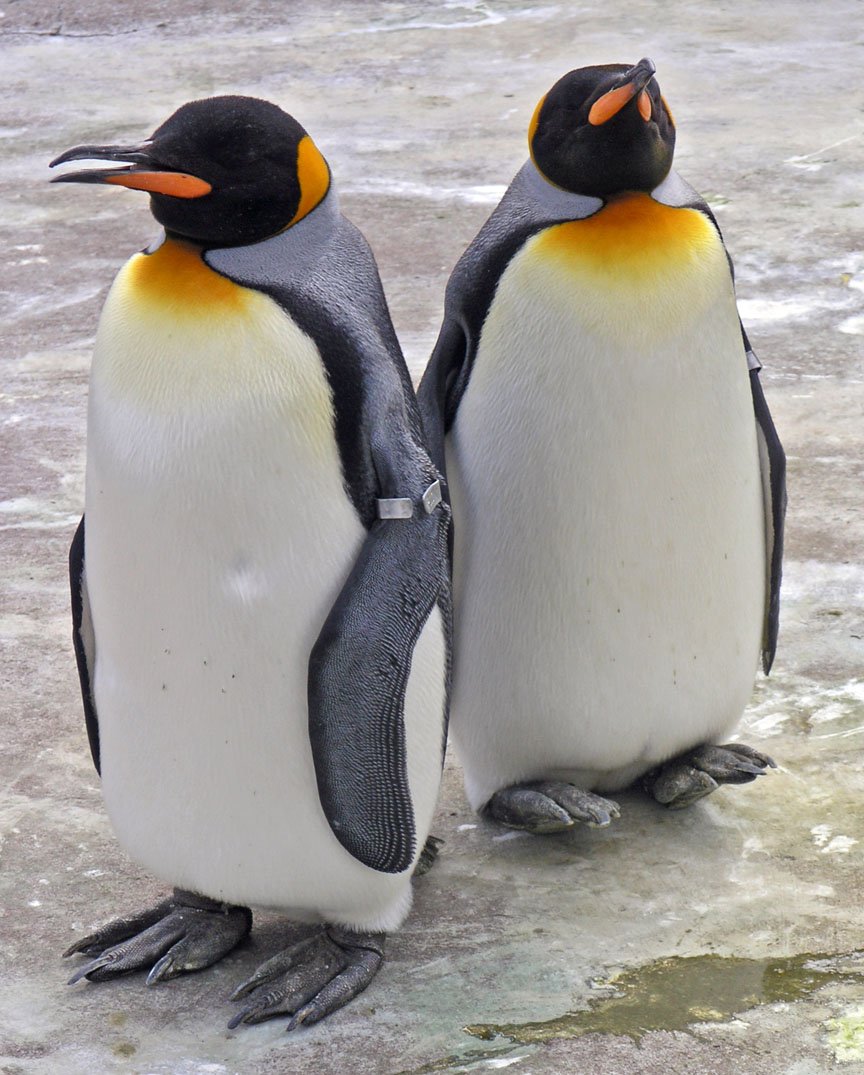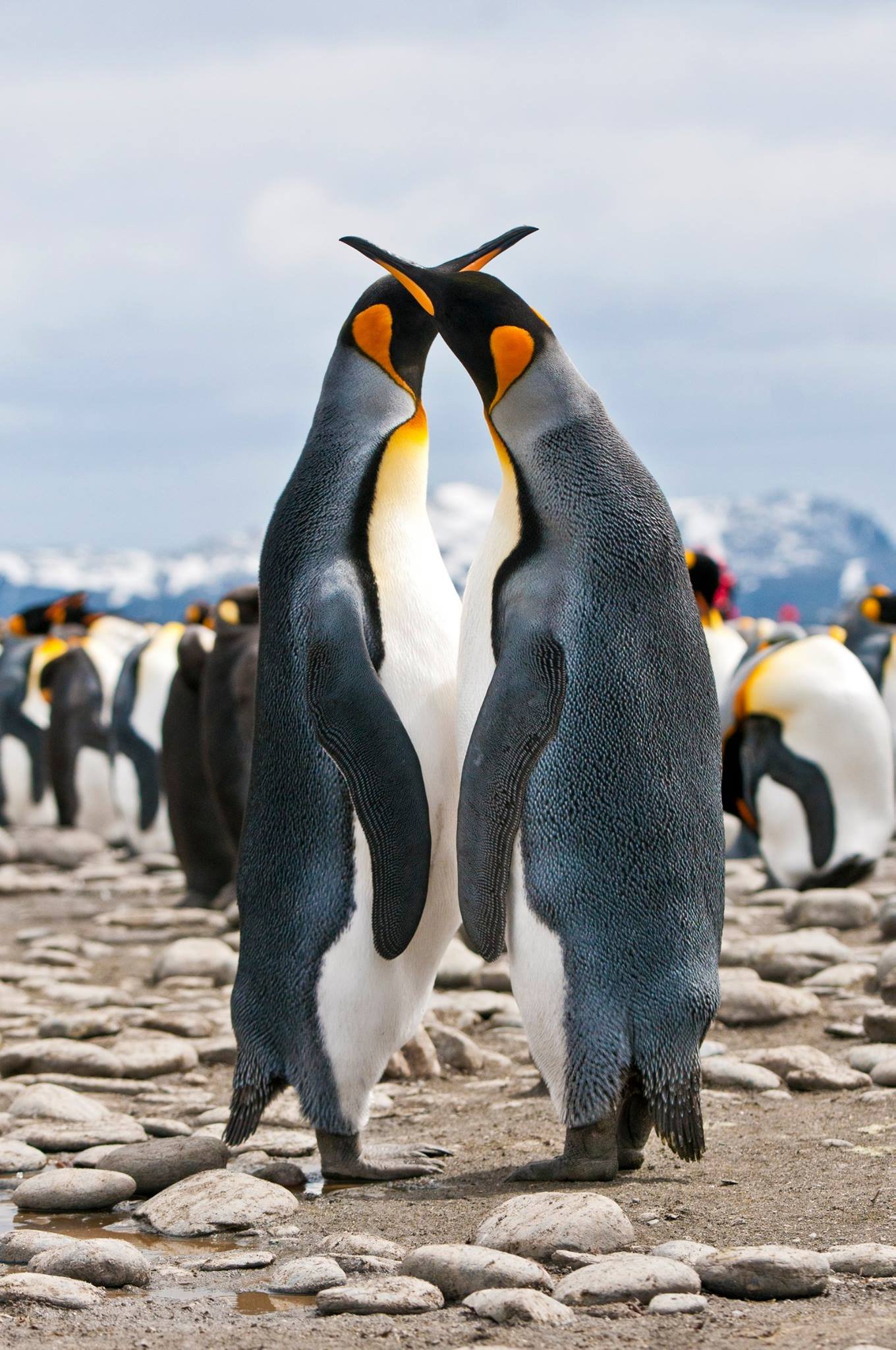The king penguin (Aptenodytes patagonicus) is the second largest species of penguins alive, and is able to grow to be a meter tall. They live on subantarctic islands on the northern reaches of Antarctica, South Georgia and a few other places in this region, but only on islands that are located between 45 and 55 degrees south. These areas have a mild temperature, and have a very rich nutrient upwelling known as the Antarctic Polar Front. You might think that they are living in complete snow cover, but the area is much more temperate than this, and it is in fact mostly not snow in these islands, with average temperatures around 10 degrees Celsius.

A pair of king penguins. Image by Wikimedia Commons user SeanMack, posted with the Creative Commons Attribution-Share Alike 3.0 Unported license.
The mild climate as well as the Antarctic Polar Front makes these island perfect for the king penguin, and for a very long time they have thrived here. Estimations put their current population number at just over 3 million penguins, and the IUCN Red List does not consider them to be of concern, so they won't go extinct anytime soon.
Despite the healthy population at the moment, the future for the king penguins might not be as bright as it seems. A recent paper published in Nature Climate Change has some grim news to report, but before we get there, we should take a closer look at the breeding and raising offspring behavior of the penguins for it to make sense.

Image by Andrew Shiva, posted with the Creative Commons Attribution-Share Alike 4.0 International license.
How the penguin penguins raises their offspring
The king penguins are mostly monogamous, and both parents do chores such as keeping the egg warm, collecting food, and looking after the young penguin. When they are collecting food for the baby, one parent leave on a long foraging trip where it can travel over a 650 kilometer roundtrip that lasts for over a week. After this time they return to the waiting family members, and then change roles with the other parent who then leave for a foraging trip.

Image by MMessina1245, posted with the Creative Commons Attribution-Share Alike 4.0 International license.
When one parent leave for this foraging trip, they essentially travel to the Antarctic Polar Front to stock up on small fish and squid, and even krill. The guarding-foraging phase last for 30-40 days in total, and during this time one parent is always leaving for several days to gather food for the chick. Luckily the chicks are able to be more independent after this time, and form a crèche: a type of penguin kindergarten where a few penguins look after many juveniles.
Why the king penguins will have problems when the climate affects the Antarctic Polar Front
When the climate changes in Antarctica, the Antarctic Polar Front is beginning to move more south. As this happens, the penguins have to travel further away from their home island to search for food, meaning that the mate and chick will have to wait even longer before they get food.
This will not really be a problem for the next few years, but the research team who published the paper we’re talking about used climatological models to find out how the scenario would look like in 2100, over 80 years from now.
At this point the penguins are in a lot of trouble. The big populations on Prince Edward and Crozet Islands are way too far away from being able to feed from the Antarctic Polar Front, and the mate and offspring will most likely die from starvation while the other parent is on a foraging trip.

Image by Liam Quinn, posted with the Creative Commons Attribution-Share Alike 2.0 Generic license.
Other colonies are also facing problems, and this current model predicts that as much as 70 % of the populations we have today will go extinct due to loss of their food source.
The best strategy for the king penguins to survive this would be to relocate to other islands that are closer to the Antarctic Polar Front which is now a bit farther south. Moving entire colonies might seem like a big problem, and it surely is dangerous, but the researchers also believe that the penguins might be capable of doing this once they need to.
Even if they are able to relocate, survival is far from guaranteed, because there are few islands in this region that can support king penguins due to their size and numbers. Some of these islands are also home to other species of penguins, which could cause conflict between the two species.
So the future for the king penguins does not seem to bright at the moment, but hopefully the relocation process is easier than we anticipate it to be for them.
Thanks for reading
Thanks for reding this grim news about the king penguins. I hope you found the post interesting despite the bad news, but of course a lot of things can happen between now and 2100, so let’s not give up just yet. If we reduce our greenhouse gas emissions soon, we might still be able to prevent this scenario from ever taking place!
About @valth
Hey, I'm @valth - the author of this post. I love to write about nature, biology, animals, nature conservation, ecology and other related branches of science, and I occasionally write about my life, about Steem or about random stuff as well. I'm trying my best to write at least one post every day, so make sure to give me a follow if you enjoy my content and want to see more of it.
Join the @valth community!
I love nothing more than to engage with my readers, so please join the @valth community in the comment section. You will definitely find more information about the topic, personal experiences, questions, and even opposing views down there, so don't miss out on learning more.
I always reward users who post good comments, so please take the opportunity to share your views and get a small upvote in exchange for it.
